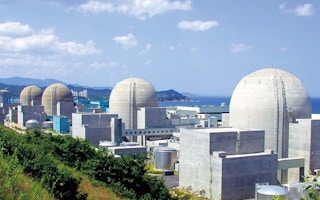If a magnitude nine earthquake occurs in waters off the northwestern coast of Japan, a tsunami measuring 10 m or even higher could sweep across the six reactors of the Uljin nuclear power plant in southeastern Korea, according to a computer simulation revealed Wednesday.
According to data the Korea Meteorological Administration submitted to Grand National Party lawmaker Lee Joung-sun, a magnitude 9.0 earthquake off the coast of Honshu, Japan would cause a 10 m tsunami to hit the coast of Uljin and Samcheok in just an hour and 48 minutes. Then the tsunami would reach the coast of Pohang two hours and five minutes later and Busan would be hit by a 5.5 m tsunami in two hours and 40 minutes.
If an earthquake of the same magnitude occurs off the coast of Hokkaido in northern Japan, Uljin, Samcheok and Sokcho would still be hit by a tsunami measuring more than 10 m in height, according to the simulation.
The six reactors at the Uljin nuclear plant are just 10 m above sea level and only 100 m from the coast with no flood barriers. “If a 10 m tidal wave sweeps in as depicted in the simulation, the Uljin nuclear plant could suffer the same fate as the Fukushima plant,” Lee said in a parliamentary hearing on Wednesday. “We need to build barriers to protect nuclear plants from possible huge tsunamis.”
Until now, two earthquakes have occurred off the coast of northwestern Japan causing tsunamis to sweep into the coast of Samcheok. A 7.7 magnitude earthquake off the coast of Honshu in 1983 sent a tsunami crashing into Samcheok in Gangwon Province, killing five people and damaging 81 vessels. In 1993, a 7.8 magnitude earthquake in the waters off the coast of Hokkaido sent a tsunami into Samcheok again.










